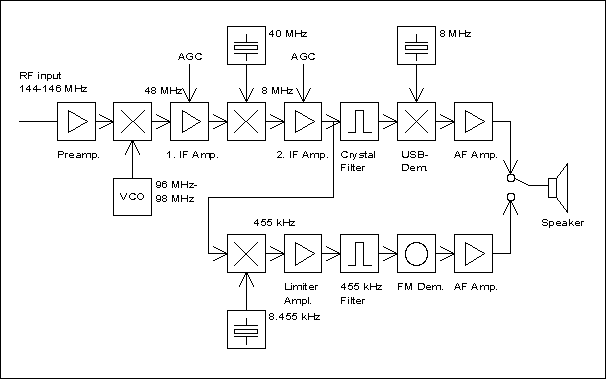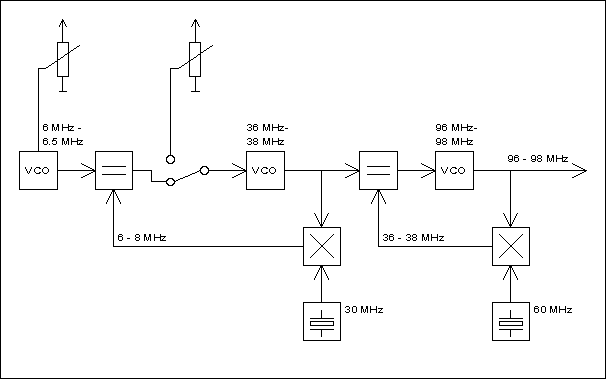
The receiver is a double-superhet for SSB and a tribble-superhet for FM. The frontend is the same for FM and SSB. The signal is splitted after the second IF-amplifier. (I used a mechanical relais for improved IP3 performance, but a diode switch or a resitive -3dB power splitter should work as well.)

Despite the fact that the VCO is painted as a small black box in the drawing above it needs some attention. While a stable freerunning oscillator can be build for frequencys up to 10 MHz it is practically impossible to build an oscillator for 96 MHz that is stable enough for SSB operation. Therefore I have developed a double returnmixing PLL for 96 MHz. Lets have a look at the schematic diagram for the VCO then we will discuss it.

Confused? Don't worry, it is not half as complicated as it looks. We start at the right. The output signal of the 96 MHz is mixed down to 36 MHz by a crystal oscillator. The 36 MHz - signal is feet into a phase comparator. The second input of the phase comparator is feet by the signal from the 36 MHz VFO.
For FM the 36 MHz VFO is free running, controlled by a helix potentiometer. The long term stability of the 36 MHz VFO is sufficient for FM and the frequency range of 2 MHz is enough to cover the european 144 MHz Band. It should be no problem to get a bigger range for covering of the US 144 MHz Band.
For SSB operation the 36 MHz signal is mixed down to 6 MHz. This 6 MHz signal is again feet into a phase comparator where it is compared to the signal of the 6 MHz VFO. This way the stable 6 MHz VFO is able to control the 36 MHz VFO which again is able to control the 96 MHz VFO. A well designed 6 MHz VFO is by far good enough for SSB, so the 96 MHz VFO in this system is good enough too. (For experts: since the time constant of the PLL loop filter is quite large, the phase noise of the 96 MHz VFO is significantly reduced also.) The frequency range of the 6 MHz oscillator is only 500 kHz but this is completely sufficient since all SSB/CW operation is located in the 144 - 144.5 MHz area.